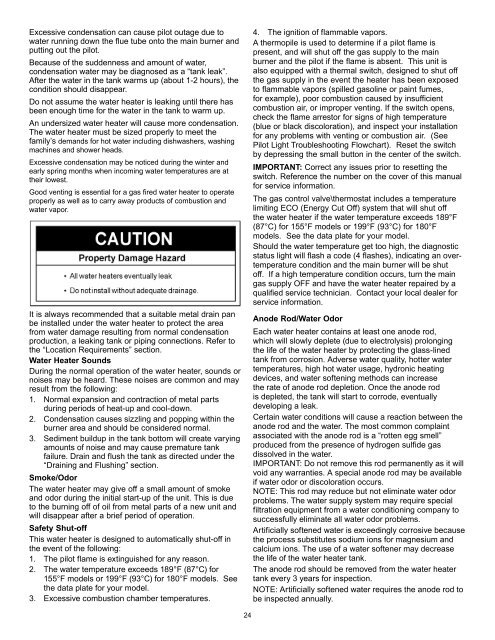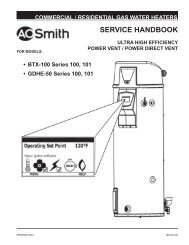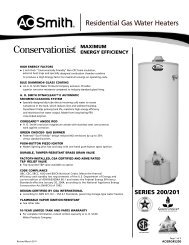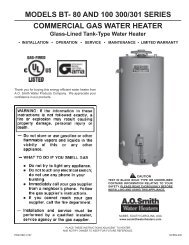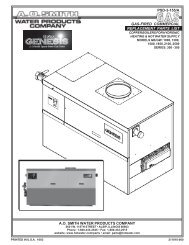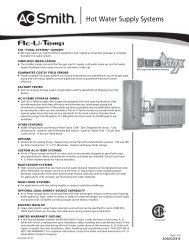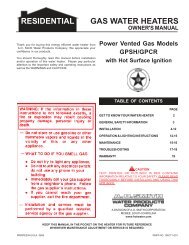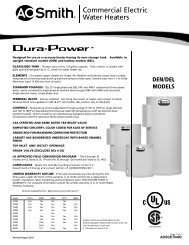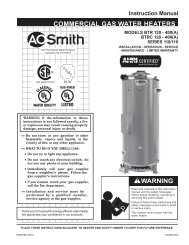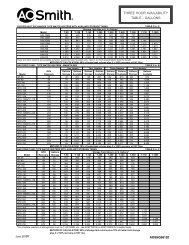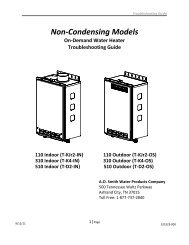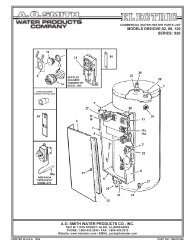320386-001 - AO Smith Water Heaters
320386-001 - AO Smith Water Heaters
320386-001 - AO Smith Water Heaters
Create successful ePaper yourself
Turn your PDF publications into a flip-book with our unique Google optimized e-Paper software.
Excessive condensation can cause pilot outage due towater running down the flue tube onto the main burner andputting out the pilot.Because of the suddenness and amount of water,condensation water may be diagnosed as a “tank leak”.After the water in the tank warms up (about 1-2 hours), thecondition should disappear.Do not assume the water heater is leaking until there hasbeen enough time for the water in the tank to warm up.An undersized water heater will cause more condensation.The water heater must be sized properly to meet thefamily’s demands for hot water including dishwashers, washingmachines and shower heads.Excessive condensation may be noticed during the winter andearly spring months when incoming water temperatures are attheir lowest.Good venting is essential for a gas fired water heater to operateproperly as well as to carry away products of combustion andwater vapor.It is always recommended that a suitable metal drain panbe installed under the water heater to protect the areafrom water damage resulting from normal condensationproduction, a leaking tank or piping connections. Refer tothe “Location Requirements” section.<strong>Water</strong> Heater SoundsDuring the normal operation of the water heater, sounds ornoises may be heard. These noises are common and mayresult from the following:1. Normal expansion and contraction of metal partsduring periods of heat-up and cool-down.2. Condensation causes sizzling and popping within theburner area and should be considered normal.3. Sediment buildup in the tank bottom will create varyingamounts of noise and may cause premature tankfailure. Drain and flush the tank as directed under the“Draining and Flushing” section.Smoke/OdorThe water heater may give off a small amount of smokeand odor during the initial start-up of the unit. This is dueto the burning off of oil from metal parts of a new unit andwill disappear after a brief period of operation.Safety Shut-offThis water heater is designed to automatically shut-off inthe event of the following:1. The pilot flame is extinguished for any reason.2. The water temperature exceeds 189°F (87°C) for155°F models or 199°F (93°C) for 180°F models. Seethe data plate for your model.3. Excessive combustion chamber temperatures.4. The ignition of flammable vapors.A thermopile is used to determine if a pilot flame ispresent, and will shut off the gas supply to the mainburner and the pilot if the flame is absent. This unit isalso equipped with a thermal switch, designed to shut offthe gas supply in the event the heater has been exposedto flammable vapors (spilled gasoline or paint fumes,for example), poor combustion caused by insufficientcombustion air, or improper venting. If the switch opens,check the flame arrestor for signs of high temperature(blue or black discoloration), and inspect your installationfor any problems with venting or combustion air. (SeePilot Light Troubleshooting Flowchart). Reset the switchby depressing the small button in the center of the switch.IMPORTANT: Correct any issues prior to resetting theswitch. Reference the number on the cover of this manualfor service information.The gas control valve\thermostat includes a temperaturelimiting ECO (Energy Cut Off) system that will shut offthe water heater if the water temperature exceeds 189°F(87°C) for 155°F models or 199°F (93°C) for 180°Fmodels. See the data plate for your model.Should the water temperature get too high, the diagnosticstatus light will flash a code (4 flashes), indicating an overtemperaturecondition and the main burner will be shutoff. If a high temperature condition occurs, turn the maingas supply OFF and have the water heater repaired by aqualified service technician. Contact your local dealer forservice information.Anode Rod/<strong>Water</strong> OdorEach water heater contains at least one anode rod,which will slowly deplete (due to electrolysis) prolongingthe life of the water heater by protecting the glass-linedtank from corrosion. Adverse water quality, hotter watertemperatures, high hot water usage, hydronic heatingdevices, and water softening methods can increasethe rate of anode rod depletion. Once the anode rodis depleted, the tank will start to corrode, eventuallydeveloping a leak.Certain water conditions will cause a reaction between theanode rod and the water. The most common complaintassociated with the anode rod is a “rotten egg smell”produced from the presence of hydrogen sulfide gasdissolved in the water.IMPORTANT: Do not remove this rod permanently as it willvoid any warranties. A special anode rod may be availableif water odor or discoloration occurs.NOTE: This rod may reduce but not eliminate water odorproblems. The water supply system may require specialfiltration equipment from a water conditioning company tosuccessfully eliminate all water odor problems.Artificially softened water is exceedingly corrosive becausethe process substitutes sodium ions for magnesium andcalcium ions. The use of a water softener may decreasethe life of the water heater tank.The anode rod should be removed from the water heatertank every 3 years for inspection.NOTE: Artificially softened water requires the anode rod tobe inspected annually.24


